This article includes a list of references, related reading or external links, but its sources remain unclear because it lacks inline citations .(May 2019) |

The Servite Church (German : Servitenkirche) is a church in Vienna, Austria.
This article includes a list of references, related reading or external links, but its sources remain unclear because it lacks inline citations .(May 2019) |

The Servite Church (German : Servitenkirche) is a church in Vienna, Austria.
On September 16, 1638, Emperor Ferdinand III allowed the Servite Order to found a monastery in Vienna.
Inspired by Italian architect Andrea Palladio, the church of the Servites was built by Martin Carlone and dedicated to the Annunciation to the Virgin. The foundation stone was laid on November 11, 1651, and the church was consecrated in 1670 though the interior decoration was completed later.
The most important work of art in the church is the "Pietà" at the altar of Our Lady of Sorrows. The tomb of general Ottavio Piccolomini, who was an active patron of the church, is located under this altar. Another patron of the church was Baron Christoph Ignaz Abele who donated the "Liborius altar".
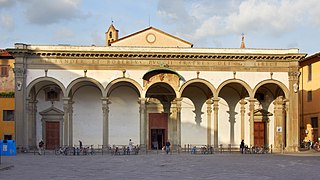
The Basilica della Santissima Annunziata is a Renaissance-style, Roman Catholic minor basilica in Florence, region of Tuscany, Italy. This is considered the mother church of the Servite Order. It is located at the northeastern side of the Piazza Santissima Annunziata near the city center.
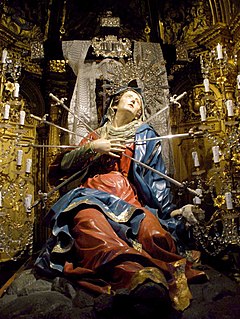
Our Lady of Sorrows, Our Lady of Dolours, the Sorrowful Mother or Mother of Sorrows, and Our Lady of Piety, Our Lady of the Seven Sorrows or Our Lady of the Seven Dolours are names by which the Virgin Mary is referred to in relation to sorrows in her life. As Mater Dolorosa, it is also a key subject for Marian art in the Catholic Church.

The Vienna Secession is an art movement, closely related to Art Nouveau, that was formed in 1897 by a group of Austrian painters, graphic artists, sculptors and architects, including Josef Hoffman, Koloman Moser, Otto Wagner, and Gustav Klimt. They resigned from the Association of Austrian Artists in protest against its support for more traditional artistic styles. Their most influential architectural work was the Secession Building designed by Joseph Maria Olbrich as a venue for expositions of the group. Their official magazine was called Ver Sacrum which published highly stylised and influential works of graphic art. In 1905 the group itself split, when some of the most prominent members, including Klimt, Wagner and Hoffmann, resigned in a dispute over priorities, but it continued to function, and still functions today, from its headquarters in the Secession Building.

Johann-Georg Bendl(Czech pronunciation: [ˈjohaŋ ˈɡɛorɡ ˈbɛndl̩]) or Jan Jiří Bendl was a Baroque sculptor, who worked mainly in Prague.
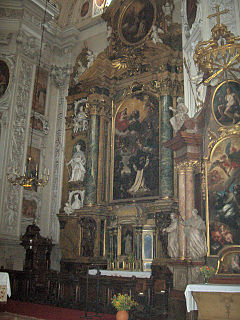
Carpoforo Tencalla was an influential Swiss-Italian Baroque painter of canvases and frescoes. He is little studied and has come only recently to the attention of art critics. He introduced the style of 17th-century Italian painting with its mythological subjects to Central Europe, reviving the art of fresco on large surfaces.

Philip Benizi was a general superior of the Order of the Servites, and credited with reviving the order. Pope Leo X recognised his cult 24 January 1516 essentially beatifying him ; and Pope Clement X canonized him as a saint in 1671.

The Diocese of Linz is a suffragan of the Archdiocese of Vienna, Austria.

Joachim Piccolomini, also known as Joachim of Siena, or, in Italian, Giovacchino Piccolomini, was an Italian Servite tertiary from Siena.

The Catholic Parish and University Church St. Louis, called Ludwigskirche, in Munich is a monumental church in neo-romanesque style with the second-largest altar fresco of the world. The building, with its round arches called the Rundbogenstil, strongly influenced other church architecture, train stations and synagogues in both Germany and the United States.
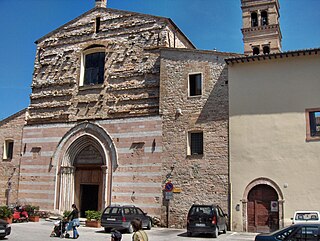
San Giacomo is a Gothic-style, Roman Catholic church located at the Piazza San Giacomo, Foligno, Italy.

The Döbling Carmelite Monastery is a monastery belonging to the Teresian Carmelites, a reformed branch of the Carmelites that arose out of the reform of the Carmelite Order by two Spanish saints, St. Teresa of Ávila and St. John of the Cross; the Teresian Carmelites thus belong to the Discalced Carmelites. The monastery stands next to a Roman Catholic church in the suburb of Unterdöbling in the 19th district of Vienna, Döbling.
The Glanzing Parish Church is a Roman Catholic parish church in the suburb of Glanzing in the 19th district of Vienna, Döbling.
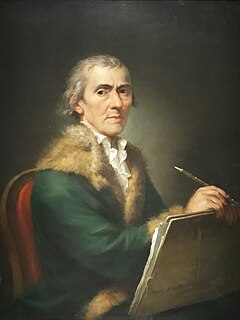
Martin Knoller was an Austrian-Italian painter active in Italy who is remembered for his fresco work.

Innsbruck Cathedral, also known as the Cathedral of St. James, is an eighteenth-century Baroque cathedral of the Roman Catholic Diocese of Innsbruck in the city of Innsbruck, Austria, dedicated to the apostle Saint James, son of Zebedee. Based on designs by the architect Johann Jakob Herkomer, the cathedral was built between 1717 and 1724 on the site of a twelfth-century Romanesque church. The interior is enclosed by three domed vaults spanning the nave, and a dome with lantern above the chancel. With its lavish Baroque interior, executed in part by the Asam brothers, St. James is considered among the most important Baroque buildings in the Tyrol.

Nicola Maria Rossi, also known as Nicolò Maria was an Italian painter of the late-Baroque.
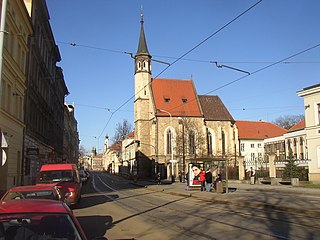
The Gothic Church of Our Lady on the Lawn is located in the valley of the Prague Botič Stream below Vyšehrad in the New Town. It is quite a small Gothic building which was built beside the monastery of Servites. The church is dedicated to the Annunciation of the Virgin Mary. The church and the monastery have been listed as historical monuments since 1958. The church was founded 24 March 1360 by Charles IV. and was built between 1360 and 1375. Its current look is mostly in pseudo-Gothic.

Santa Maria ad Ogni Bene dei Sette Dolori, also known as Santa Maria de Sette Dolori, is a Roman Catholic church in Naples, Italy. It stands on a hill, providing an excellent view of Spaccanapoli, a Decumanus of Naples which ends across via Francesco Girardi. From the door of the church, one has a direct view across Naples through the straight decumanus. The church also faces the former convent of Santissima Trinità delle Monache.
Andrea Bertoni was an Italian Roman Catholic priest and a professed member of the Servite Order. Bertoni assumed the religious name of "Giacomo Filippo" upon being admitted to the Servites and he became the procurator of the convent he lived in from his appointment until his death.

The St. Canisius's Church is a Roman Catholic parish church in the 9th District of Vienna, Alsergrund.

The church and convent of the Santissima Annunziata is a Baroque-style, Roman Catholic church located on Piazza de Servi #4, Pistoia, region of Tuscany, Italy. The convent presently functions as a warehouse. The church is down via Laudesi from the San Desiderio, and via Piazza de Servi, From San Giovanni Decollato.
![]() Media related to Servite Church, Vienna at Wikimedia Commons
Media related to Servite Church, Vienna at Wikimedia Commons